
Mystery of the Upper Room Revealed
Every Picture Tells the Story
"And Jesus said to them, listen, when you enter the city you will meet a man carrying a pitcher of water. Follow him into a house … say to the owner of the house, 'The Master says to you, where is the guest room where I will eat the the Passover with my disciples?' Then he will show you a large upper room already furnished: There you will prepare the meal." (Luke 22: 10-12)
The traditional location of the Upper Room, as featured in the story of the Last Supper, is located on the southern end of the Temple Mount. Tens of thousands of Christians visit this site each year eager to stand where Jesus and His disciples experienced momentous events. It was here that Judas made his decision to betray Jesus. And, it was here that Jesus declared a new covenant of grace and mercy verses the old mosaic covenant of law and punishment (Mark 24:14-15). This may have also been the room where He first appeared to His disciple on the evening of resurrection Sunday (Luke 24:33, 36; John 20:19, 26). And some theorize that this was the house where the disciples were in prayer when the Holy Spirit appeared to them.
However, in this particular case, the word house concerning the arrival of the Holy Spirit more probably referrers to the House of the Lord or the Temple. The Temple was located in the middle of a large plaza or court yard the size of nineteen football fields. This expanse included roofed colonnades on all four sides that provided shade, and served as areas where the religious leaders could conduct classes and give sermons. This was where Jesus would go to teach His followers. The disciples were apparently sitting together in the court yard near the Temple's southern entrance gate waiting to attend the upcoming Pentecost ceremony. This fourth of the seven annual Jewish feasts commemorated the giving of the Law on Mount Sinai were 3,ooo Jews were killed for idol worshiping (Exodus 32:28).
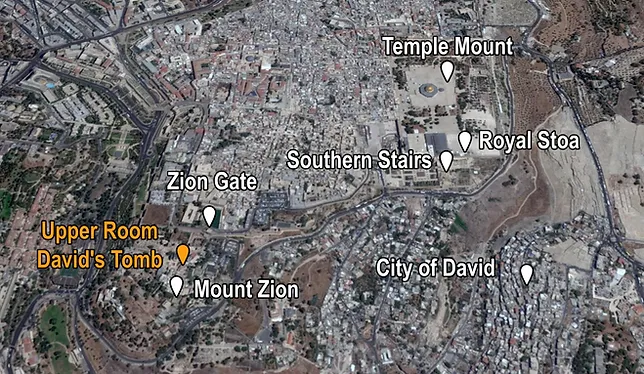
The disciples were in prayer and watching as Jewish pilgrims from throughout the Mediterranean area climbed the Southern Stairs, passed through the Temple's Southern Gate and into the plaza (Acts 2:5-15). It was then that the area was suddenly filled with the loud sound of a rushing wind, but there was no breeze. Suddenly, a flame appeared above the heads of each disciples. This would have caught the attention of many thousands of Jews standing in the plaza. The disciples, now indwelled by the Holy Spirit, stood and began to walk through the crowds preaching the Gospel of Jesus as Messiah (Acts 2:1-4). The people were amazed when they came to realized that the words of a disciple, were heard by a listener as if spoken in that person's own native tongue. In other words, as a disciple spoke, every one who heard him understood what he was saying because he was speaking their own language. This was obviously a miracle and the crowd stood in stunned disbelief while watching this event unfold. Some began to cry out it was the power of God while others said the disciples had drunk too much wine. It was then that Peter quieted the commotion, preach the Gospel, and 3,000 Jews were baptize and received eternal life (Acts 2:41, 46).
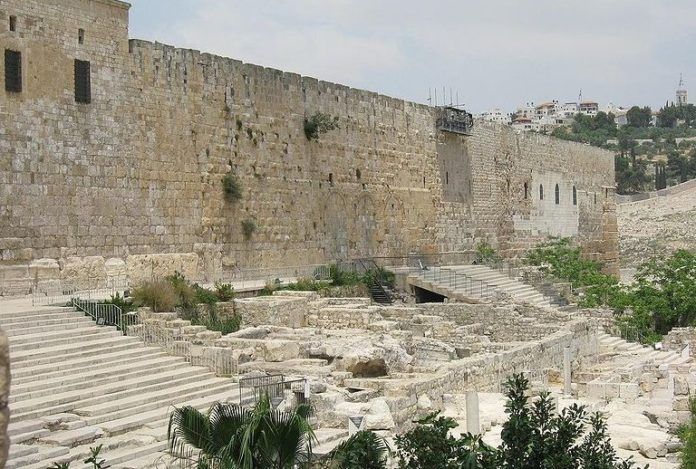
So, Peter's sermon could only have taken place in the Temple's plaza and the 3,000 baptisms could have taken place in the putrification pool or Mikvah located adjacent to the Southern Steps.
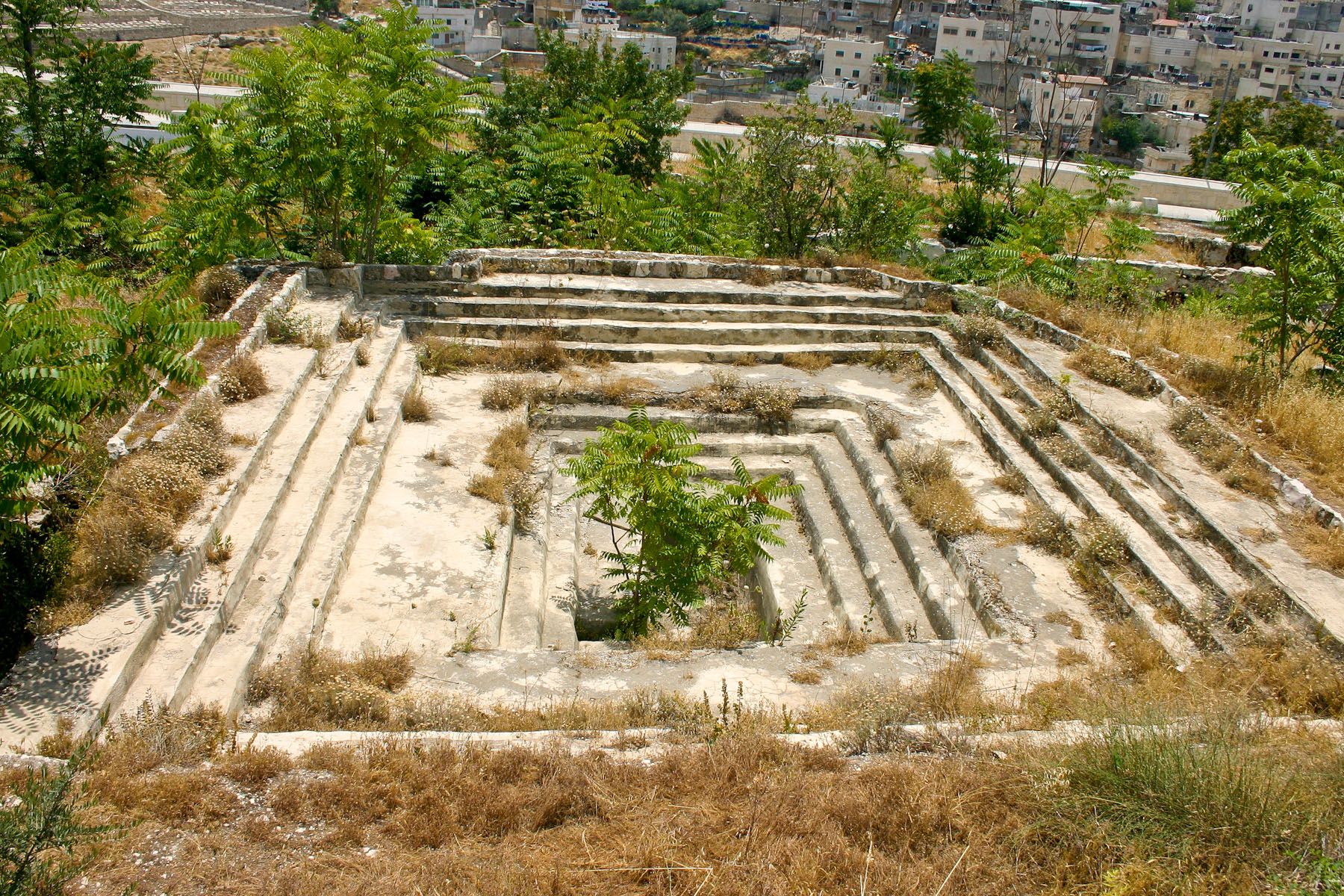
A crowd of over three thousand people could never have gathered in the narrow street outside the house with an Upper Room. The logistics would have also made it impossible for the crowds to see the flame of the Holy Spirit and hear the apostles speak in foreign tongues. It would also have been impossible for a crowd of three thousand to have heard Peter's sermon and then have been baptized. (news.kehila.org, "Walking in His Peace-The Southern Steps of the Temple Mount").
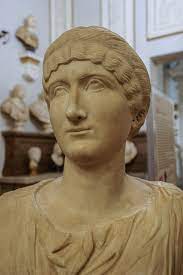
It would have been nice and more convenient if Helena, the Mother of Emperor Constantine, had chosen to also enshrine this site in 330 A.D. She had converted to Christianity and took a one year tour of Israel to worship at those places that were important in the life and ministry of Christ. Her son had also agreed to build churches over those sites her research found to be authentic in order to preserve them against any acts of destruction by man or nature. But, because she was not given an unlimited budget to work with, she was forced to narrow her list to the top six sites she considered to be of most importance to Christendom. Please see related: "How Sacred Sites Were Discovered".
Because she was not able to have the house with the Upper Room preserved at that time, we now find historian and archeologists, one thousand seven hundred years later, slow to agree that this house is the house that contained the Upper Room. Some archeologist have suggested the building may be the partially surviving remnant of a Byzantine church constructed in 410 A.D. to commemorate the exact spot where Mary, the mother of Jesus, was said to have died. This church was known as Hagia {Holy} Sion {Zion} and was destroyed in 614 A.D. It is theorized that this surviving part of this church inherited many Christian relics and shrines that were once housed throughout the church. So, this building became venerated, and because the church was now gone, it was assigned the title of the Upper Room. Other archeologists believe that the building or house predates the Hagia Sion church. Meanwhile, biblical scholars only have a few vague literary accounts written circa 350 A.D. to work with in trying to authentic the house. So, scholars are forced to decide on the authenticity of this building based on one of two theories. The Upper Room was either in a house that existed by the first century, or it is no more than the wrongly identified remains of a portion of a larger church.
However, there is a third seldom considered class of evidence concerning the location of the house with an Upper Room. There are five known ancient artistic renderings of Jerusalem that feature a house that stands out from the surrounding buildings. This house is always pictured next to the Hagia Sion church, it is always two stories tall, and it always has an unusual lean-to roof line that is colored red. Two of these rendering are in mosaic tiles, two are relief carvings and one is a drawing. These renderings have always been discounted by scholars as evidence because the they cannot be dated to the first century. But the fact remains that these five early Christian maps and depictions of Jerusalem include this same unusual looking house in all their motifs. Here are the five illustrations for your consideration.
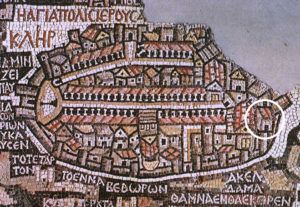
The most direct reference to this structure is a detailed mosaic map of the Holy Land and in particular Jerusalem. It is found in the Church of St. George in Madaba, Jordan and dates to circa 550 A.D. The north side of the city is on the left and shows a main street known as Cardo Maximus running to the southern end at the right. This street was built by Rome after the second and final ill-fated revolt of the Jews in 132 A.D. Located at the far right are two sacred structures identified by their red roofs. The large building is universally agreed upon as being the Hagia Sion. The smaller structure to the right of the church with a sloping or slanted lean-to red roof is a prime candidate for the Upper Room. Some scholars theorize that the building was constructed as a monastery adjacent to the church. But no other monastery shown on the map is colored with a red roof, only these two structures located together and where the Upper Room is located today. Also, there is no archeological evidence that a monastery was ever there. Other scholars have suggested that this building may be the remains of the right side of the destroyed basilica. Therefore, if you add a similar building to the left with the longer worship auditorium running down between them, they would combine to form a cross. This is better seen by looking down at the basilica from above. But there is no corresponding opposite side building foundation remains to support this theory.
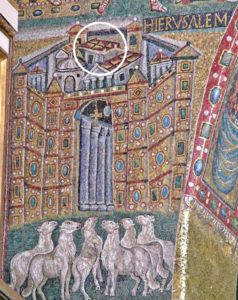
There is another mosaic found in the Saint Maria Basilica in Rome that was also created circa 550 A.D. It also shows the main street of Jerusalem and the red roofs designating religious structures. The front building represents the Church of the Holy Sepulcher. Behind this structure is the Hagia Sion Basilica with the Upper Room located to its right. Once again, this building has a sloping or slanted lean-to red roof just as depicted in the Madaba mosaic.
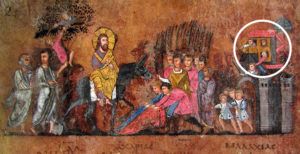
A third depiction of the Upper Room can be seen in the Rossana Gospels drawing circa 550 A.D. It shows Jesus’ triumphant entry into Jerusalem riding a donkey. Above, people lean out of the windows of a two story building. They are cheering Jesus the Messiah as He rides by. The building once again has the unique sloping or slanted lean-to red roof. Behind it we can see the Church of the Holy Sepulcher. These two structure are still today located in these exact same positions.
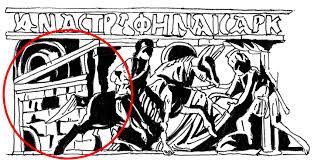
There is a relief carving circa 350 A.D. that details a two story structure inside the walls of Jerusalem. This depiction features a building with a slanted roof and the Dome of the Rock in the background with the arch of the east city gate. The sloping or slanted lean-to roof can be seen in front of the gate. It would be hard to explain why the artist was featuring this peculiar shaped building if it was not important as in the Upper Room.
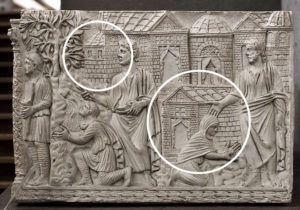
There is a relief carved into the side of a sarcophagus circa 350 A.D. To the right of the scene Jesus is either healing the woman with an issue of blood (Mark 5:25), or is giving comfort to Mary Magdalene after his resurrection (Matthew 28: 9-10; John 20:17). However, in the upper far left background, we see a two story house next to a fig tree which once again features a unique sloping or lean-to roof structure. If the scene on the right is Jesus with Mary, then its relationship to this slanted roofed building would seem to imply that Jesus appeared to His disciples and Mary in this house with its Upper Room.
So, considered as a whole, the archeological studies combined with these artistic renderings create a compelling case that while the Upper Room was at one time located adjacent to the Hagia Sion Basilica, it existed before the church was constructed in 410 A.D. and was preserved after the church was destroyed in 614 A.D. as shown in these five artistic renderings from the fourth and sixth centuries.
Thus, there is enough consistent factual evidence to rightly deduce that the house now on display in Jerusalem does in fact contain the Upper Room. The few theories that it is not the correct house are just that, theories that cannot be corroborated by facts. And, a theory that is not backed by facts will always remain only a theory.
On a closing note, oral tradition states that the Hagia Sion Basilica was built over the exact spot where Mary the Mother of Jesus was said to have died. And, the location of the Basilica was also noted as being appropriate as it was located, “adjacent to the Upper Room”!
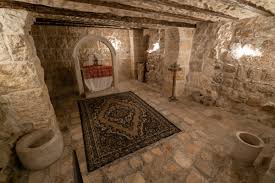
If you enjoy the information provided on this site, please consider making a donation of any amount to help continue its production. Donate Now